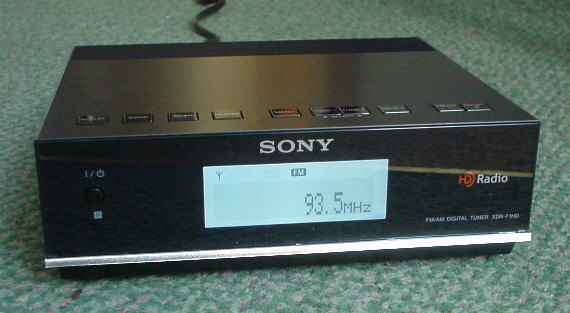
The Sony XDR-F1HD AM-FM 'HD' Tuner has rightly been accepted by the 'FM-DX' community as a superbly sensitive and selective receiver for weak-signal use in the VHF Broadcast band.
The HD digital modes are not used outside of the USA, but the analogue FM receiver can be used throughout the world for Band II reception.
The audio quality is clear and the stereo is noise-free even for weak signals and in the presence of strong adjacent-channel signals.

A serious review of the XDR elsewhere on the 'web gives details of the circuit and suggested modifications, and further reviews can be found (1,2,3)
The reviews seem to concentrate on the audio quality of HD reception, but the FM reception quality will also satisfy enthusiasts, though the audio response needs modification for optimum fidelity outside of the Americas - see below.
The power requirements are 120V 60Hz. If you intend to use the XDR outside of the Americas, you will require a transformer to supply the 120V at about 15W. Be aware that 50Hz operation will increase the heating from the mains transformer, to the point at which cooling modifications are necessary - see below.
Two brief points about the tuning steps and the RDS decoding:
The 100kHz tuning step is felt to be a weak point for dx-ing, and it would be nice to try it with smaller steps. I tried using a signal generator to replace the internal master clock signal, and the results were not noticeably useful. A 50kHz step would be pointless as neither adjacent channel is received, but a step of 10 or 25kHz from nominal does reduce strong adjacent-channel qrm slightly. Shifting the internal clock frequency by ±10kHz is not practical so we'll have to live with 100kHz steps.
All demodulation and data decoding is done in the DSP chip, so the baseband multiplex signals are not available for external demultiplexing, but the RDS data and clock are available. It is possible to extract the RDS data from the micon board for decoding with the normal software, and Olivier Guillaume has successfully done so and extracted the PI + PS codes and the S-meter data, for the benefit of Global Tuners operators who run an XDR, while Cédric Lamouche has developed a stand-alone RDS decoder (4)(5)(6)
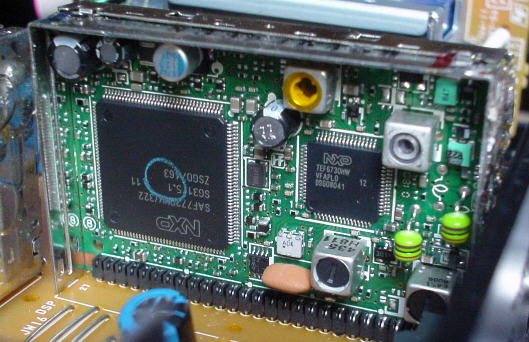
The 'Front-end' chip is the TEF6730, a veritable power-house of RF engineering. This operates with a 40.600MHz clock and provides image-reject mixing to 10.7MHz. The IF signal is filtered by a single ceramic filter, switchable for analogue or digital radio. The IF signal is subsequently processed by the SAF7730 which determines the bandwidth of the virtual passband.
Among the many interesting features of the TEF6730 front-end IC are:
Provision for tuning LW & MW in 1kHz steps and HF from 2.3 - 26.1MHz in various small steps
Provision for the three FM broadcast bands, with 50kHz steps for Band II, 33.3kHz for Japan and 6.66kHz for OIRT
Software alignment of the aerial tuned circuit and the 'tracking', avoiding the need for mechanical adjustment.

To get the smaller tuning steps would require an external data stream to the I˛C bus of the 6730, and the additional frequency coverage would also need modifications to the aerial tuned circuits. This is not feasible in the XDR-F1HD
I see there are two solderable links on the controller board, which opens up a vista of exciting possibilities. Unfortunately, I saw no changes in operation of the receiver for all four possible settings of the links - perhaps they are related to the 'HD' digital audio options for the USA market.
I conclude that few useful modifications to the receiver functions are possible because of the density of small tracks on the smt pcb. What would most be worthwhile are the addition of a fan, a memory-retention battery, conversion to 12V operation, and de-emphasis correction for use outside of the Americas, all of which can be done without disturbing any smt devices.
A small fan can be fitted to reduce the high operating temperature of the components. High temperatures will inevitably shorten the servicable life of the receiver, and the tuner module and the HD module run rather too hot in the XDR-F1HD. In the later HD radio model XDR-S3HD Sony have added a cooling fan
If the unit is to be run from a 50Hz supply without modification, the mains transformer also will run hot, so the supply voltage should be kept around 110V if possible.
Sony seem to have fitted a sheet of PCB material in the lid of the XDR-F1HD to spread the heat from the modules, rather than leave more vent holes. A 40mm 12V fan would be ideal for cooling, or a 50mm type as used for CPU cooling could be retrieved from an old PC. A 12V fan can be run from the +5.2V line from the PSU board, running quietly to provide a gentle upwards airflow, and will run only when the XDR is 'on' if an additional switching transistor is used (see Brain Beezley's modifications for details). Make sure the fan lines up reasonably with the vent holes.
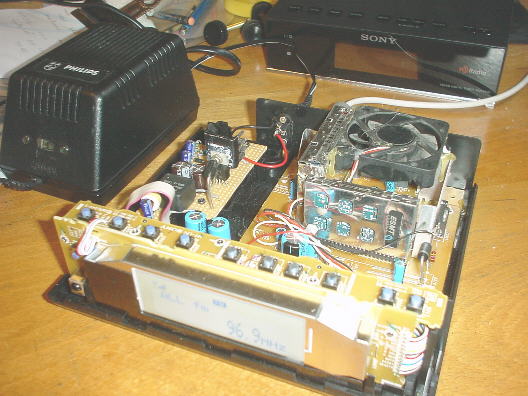
Below, a small N-chan MOSFET (eg 2N7000) is used for switching a 50 × 10mm fan: S - gnd, G - D915a, D - Fan -ve, and fan +ve to JW1 or 21. If the fan has a 3rd wire (speed sensor), leave it disconnected
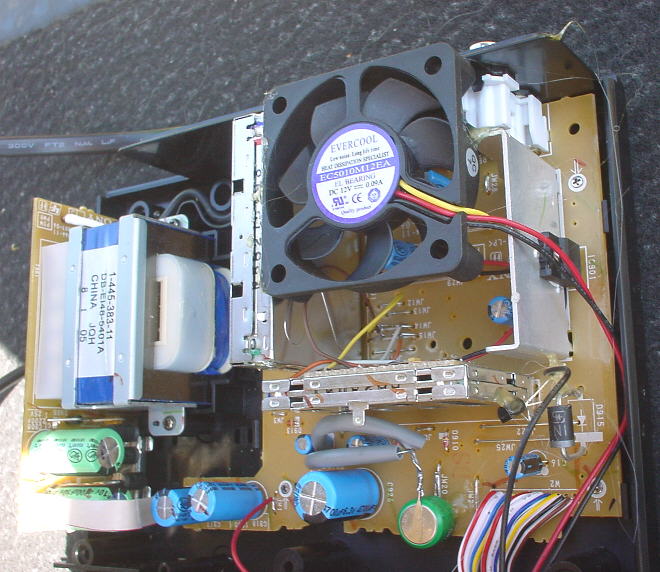
When used in the UK on 50Hz mains, it is desirable to reduce the XDR's supply voltage below the quoted 120V for the sake of its 60Hz mains transformer. As the commonly-available auto-transformers give 120V when run from 240V, I recommend that you wire a 240V filament bulb in series with the auto-transformer primary. Mount the correct electrical fittings - batten lampholder, single socket & plastic pattress to suit - on a wooden board and use a 60W or 100W FILAMENT bulb to reduce the XDR supply to 100 - 110V
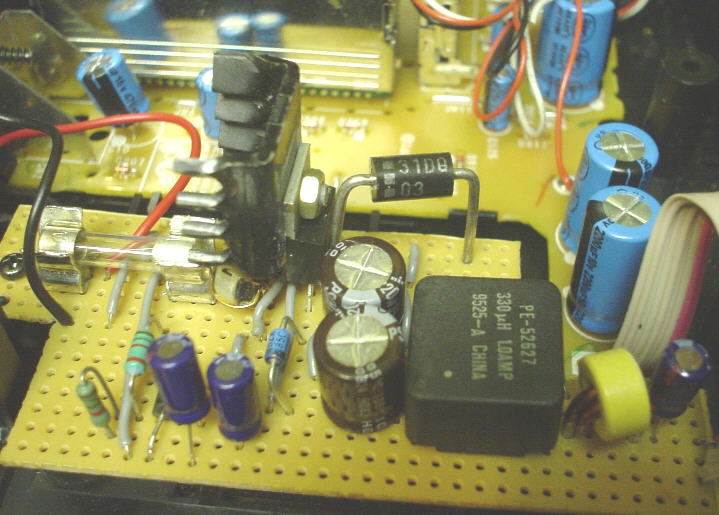
The PSU board could be replaced by a pair of regulators to reduce +12V down to 10.5V (±0.5V), at 200mA, and 5.0V at 1.0A. The receiver would then operate from an external 12 - 15V supply, requiring 1.2A assuming linear regulators. I preferred to convert my XDR for 12V operation using a TS2567 switching regulator, as this reduces the supply current requirement* and it runs a lot cooler than a linear regulator. In fact the XDR now runs a lot cooler than it did with the original transformer PSU, especially in 'standby'. The schematic can be seen here, and uses components which are readily available from RS or Farnell
The 50kHz switching regulator does not cause any problems on VHF. The harmonics can, of course, be heard on MW, but for normal domestic listening they can be nulled with the loop aerial. The radiated harmonics could probably be reduced further by screening with tinplate. The fan appears to create more RF noise than the switching regulator, and in any case the XDR is unsuitable for MW-DX outside of ITU Region 1.
* about 780mA in operation and 60mA in standby

The clock and preset channels are held in dynamic memory in the microprocessor and are lost if the unit is de-powered for more than a few minutes. The µP supply current is only a few µA when the unit is off, but is less predictable during startup and power-down. I have tried using a rechargable battery to maintain the µP supply but the battery voltage is forced to 3.3V during operation and correct charging of the battery is not possible. If C926 is supplemented with a high-value memory capacitor, retention can be extended to a few hours, as described in Brian Beezley's article (1)
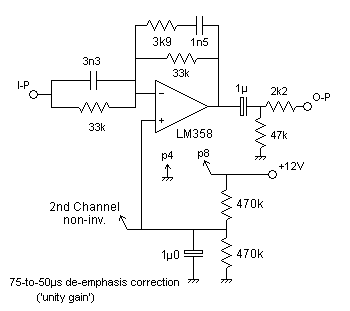
For FM broadcasting, an HF boost is applied to the transmitted audio and a corresponding roll-off is made at the receiver, in order to reduce the hiss which is so familiar on FM. This pre-emphasis gives a lift of 6dB/octave above a specified frequency, requiring a corresponding roll-off in the receiver. Historically the USA chose a time-constant of 75µs while Europe chose 50µs, corresponding to 3dB points of about 2.1 & 3.2kHz respectively.Thus any US tuner will sound a little lacking in treble in the rest of the world.
To correct this when using any USA tuner outrside of the USA, a simple op-amp circuit can be added externally, such as the one shown here. This was based on a more detailed circuit, intended for rather more critical modification of the XDR, and I am grateful to Peter Körner who did the calculations.
His design can be seen here
Brian Beezley also has an audiophile 'external' correction amplifier among his designs, with full details of the circuit design and frequency response - follow Brian's link to 'more' of his pages.
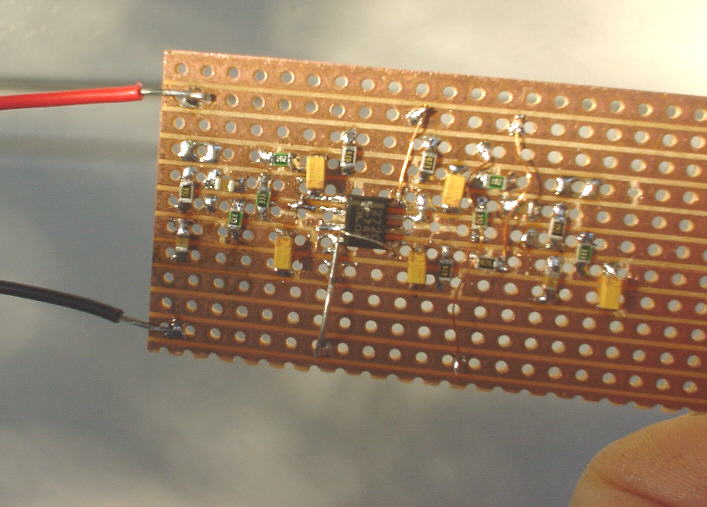
If the de-emph correction is to be mounted internally, you can omit the output coupling capacitor and the two resistors on each channel. Cut JW14 + 15 and insert the correction amplifier, I-P to the side nearest the tuner module. I took the +ve supply from C302 (8V regulated).
Showing the De-emphasis Correction PCB glued to the side of the HD Module:
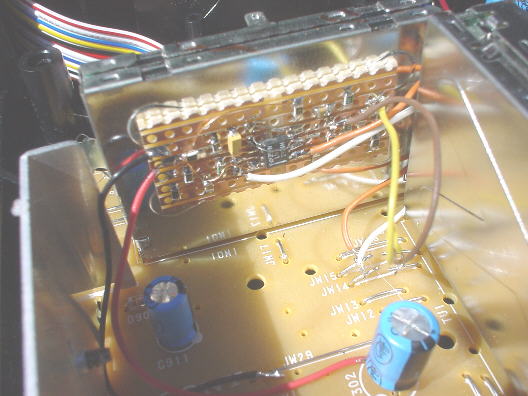
The XDR would benefit from a few more modifications, most importantly the decoding of the RDS & signal-strength data, which so far has been done using a microcontroller board driven from the Global Tuners interface on a PC (5)
Also I want also to add an outboard audio amplifier with volume control to drive headphones or small speakers. This could include the de-emphasis correction, and would run from the same 12V supply as the modified XDR
(1) Brian Beezley has the definitive article on the XDR including some suggested modifications, and a very detailed analysis of the performance
(2) Pat Dyer gives a "subjective review" from a seasoned dx-er's perspective
(3) Hillel Hachlili describes his Lithium Ion battery and external fan modifications, which have given good service
(4) Global Tuners is a project which provides access to remotely controlled radio receivers all over the world. A few XDR's are available for registered users
(5) More details about using the XDR on GT
(6) Stand-alone RDS decoder
J.Hardstone - Last updated 8 Nov.2010
